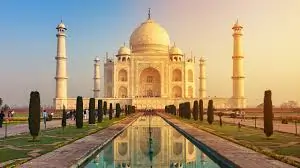Taj Mahal, renowned for its stunning symmetry, intricate inlay work, and reflecting pools, it stands as a symbol of eternal love and one of the New Seven Wonders of the World.
ADVERTIDEMENT

Table of Contents

Taj Mahal
The Taj Mahal, located in Agra, Uttar Pradesh, has a profound history that combines love, artistry, and architectural genius. Built in the 17th century by the Mughal Emperor Shah Jahan, it serves as a mausoleum for his beloved wife, Mumtaz Mahal, who died during childbirth in 1631. Grieving deeply, Shah Jahan vowed to create a structure that would symbolize their love and stand as a lasting tribute.
Construction began in 1632 and took over 20 years to complete, employing thousands of artisans, craftsmen, and laborers. The complex was designed by a team of architects led by Ustad Ahmad Lahauri, and it incorporates a blend of Islamic, Persian, Ottoman, and Indian architectural styles. Crafted primarily from white marble inlaid with semi-precious stones, the Taj Mahal’s iconic dome, minarets, and intricate calligraphy make it one of the most recognized structures in the world.
The Taj Mahal was completed around 1653, and upon his death, Shah Jahan was laid to rest beside Mumtaz Mahal within the mausoleum. Over centuries, the Taj Mahal has not only been celebrated as an architectural masterpiece but also as a symbol of undying love and devotion. Recognized as a UNESCO World Heritage site in 1983, it continues to draw millions of visitors each year, who come to marvel at its beauty and historical significance.
I. Introduction
Global Significance of the Taj Mahal
Introduction to the Taj Mahal as one of the most recognized structures in the world and an architectural marvel. Symbolism of the Taj Mahal: Representing timeless love, artistic achievement, and Mughal imperial power.
Location and Recognition
Located in Agra, Uttar Pradesh, India, along the Yamuna River. Status as a UNESCO World Heritage site since 1983 and one of the New Seven Wonders of the World.
Impact on Global Heritage and Tourism
Mention its appeal to millions of international and domestic visitors each year. Introduction to its impact on global heritage as an exemplar of Mughal architecture and a cultural treasure.
II. Historical Context and Background
The Love Story of Shah Jahan and Mumtaz Mahal
Background on Shah Jahan, the Mughal emperor, and his deep bond with his wife, Mumtaz Mahal. Mumtaz Mahal’s death in 1631 during childbirth and the emotional toll it took on Shah Jahan. Shah Jahan’s vow to build a monument that would honor her memory and capture their love story.
Commissioning of the Taj Mahal
Shah Jahan’s vision of the Taj Mahal as a monument that would symbolize the grandeur of the Mughal Empire. Political and personal motivations behind the construction, reflecting both love and imperial prestige. Historical significance of the Taj Mahal in the 17th century as a statement of Mughal power and architectural mastery.
III. Design and Architectural Innovation
Construction Timeline and Workforce
Construction initiated in 1632, spanning over 20 years, with completion around 1653.Diverse workforce of artisans, masons, stonecutters, inlayers, and laborers from across India, Persia, and Central Asia.
Primary Materials and Techniques
Use of white Makrana marble, prized for its quality and ability to reflect light, creating a shimmering effect at different times of the day. Semi-precious stones sourced from various regions for pietra dura (inlay) work, including jade, lapis lazuli, turquoise, and sapphire.
Architectural Leadership and Collaboration
Chief architect Ustad Ahmad Lahauri led the project with influences from Persian, Ottoman, and Indian design traditions. The collaborative efforts of craftsmen and artists from different cultures, resulting in an architectural masterpiece that transcends individual styles.
IV. Architectural Features and Symbolic Elements
The Mausoleum Structure
Central onion-shaped dome, an architectural marvel that rises 240 feet, surrounded by four symmetrical minarets. Minarets designed to lean slightly outward, serving as a structural safeguard against earthquakes. Emphasis on perfect symmetry, symbolizing harmony and balance.
Pietra Dura and Marble Inlay Work
Elaborate floral and geometric inlay work using semi-precious stones, exemplifying Mughal artistry and craftsmanship. Inscriptions of verses from the Quran on the arches and entrances, reflecting Islamic calligraphy and religious reverence.Use of various floral motifs symbolizing paradise, beauty, and spiritual ideals.
Complex and Intricate Design Elements
Precision of details, from the smallest inlay to the grand symmetry of the structure.Design focus on the interplay of light, creating a dynamic visual experience as the marble changes colors throughout the day.
V. The Larger Complex and Surrounding Structures
Charbagh Gardens and Layout
Charbagh garden, a traditional four-part Persian-inspired layout symbolizing the Islamic concept of paradise. Division of the garden into quadrants with water channels and fountains, emphasizing peace and symmetry. Walkways and lush greenery creating a tranquil environment, enhancing the spiritual and contemplative experience for visitors.
Reflecting Pool
Central pool specifically designed to mirror the image of the Taj Mahal, amplifying its visual impact. Reflection as a symbolic element, doubling the image and creating an illusion of perfection and ethereal beauty.
Additional Structures: Mosque and Guesthouse
Red sandstone mosque on one side, used for religious purposes, enhancing the Taj Mahal’s cultural and spiritual context. Matching guesthouse (mehmankhana) on the opposite side to create symmetry, used historically to house visitors and accommodate ceremonies.
VI. Symbolism and Cultural Significance
Representation of Eternal Love
The Taj Mahal as a testament to Shah Jahan’s love for Mumtaz Mahal, commemorating her legacy through an architectural marvel. Romantic symbolism that has made the Taj Mahal a global icon of love and devotion.
Spiritual and Artistic Ideals of the Mughal Empire
Reflects the Mughal ideals of spirituality, art, and imperial pride. Embodies Islamic aesthetics and Persian influences while integrating Indian architectural elements.
Cultural Influence and Enduring Symbolism
Influence on global art, literature, and popular culture as a universal emblem of beauty and devotion.Symbolism of the Taj Mahal in modern culture as a universal representation of love, transcending cultural and religious boundaries.
VII. Historical Impact and Recognition
Legacy Over the Centuries
Historical status through the colonial era, with European travelers marveling at its grandeur. Challenges faced over centuries, including pollution, erosion, and preservation needs. The Taj Mahal’s role in shaping India’s national identity as a representation of its rich history and culture.
Recognition as a World Heritage Site
Designated as a UNESCO World Heritage site in 1983, securing its status as a monument of international importance. Inclusion as one of the New Seven Wonders of the World, amplifying its place in global heritage and tourism. Efforts by UNESCO and conservation bodies to protect the monument for future generations.
VIII. Tourism and Modern-Day Relevance
Visitor Experience and Key Viewing Times
Best times to visit, particularly during sunrise and sunset, when the marble changes colors in the shifting light. Special arrangements for night viewings under the full moon, offering a unique and mystical experience. Overview of the visitor experience, including entry details, guided tours, and cultural insights provided by local experts.
Preservation and Conservation Efforts
Initiatives by the Archaeological Survey of India, UNESCO, and environmental groups to address pollution and maintain structural integrity. Environmental challenges posed by river pollution, air quality, and high tourist traffic, and the measures taken to mitigate these effects. Long-term conservation plans to ensure that the Taj Mahal remains accessible and preserved for future generations.
Economic and Cultural Impact on Agra and India
Role in bolstering Agra’s economy, particularly in tourism and local industries like hospitality, crafts, and transportation. Cultural significance as a source of pride for India, symbolizing the country’s heritage, artistry, and historical depth. Global cultural impact, inspiring replicas, artworks, and literary references around the world.
IX. Conclusion
Taj Mahal stands as one of the world’s most cherished landmarks, embodying timeless love, exceptional artistry, and the cultural richness of the Mughal Empire. From its intricate inlay work and balanced symmetry to its serene surroundings and enduring symbolism, the monument remains a testament to human creativity and devotion.
Recognized as a UNESCO World Heritage site and one of the New Seven Wonders of the World, the Taj Mahal continues to inspire admiration across generations and cultures. As a globally celebrated icon, its preservation not only honors India’s heritage but also ensures that future generations can experience and appreciate its unparalleled beauty and historical significance.

